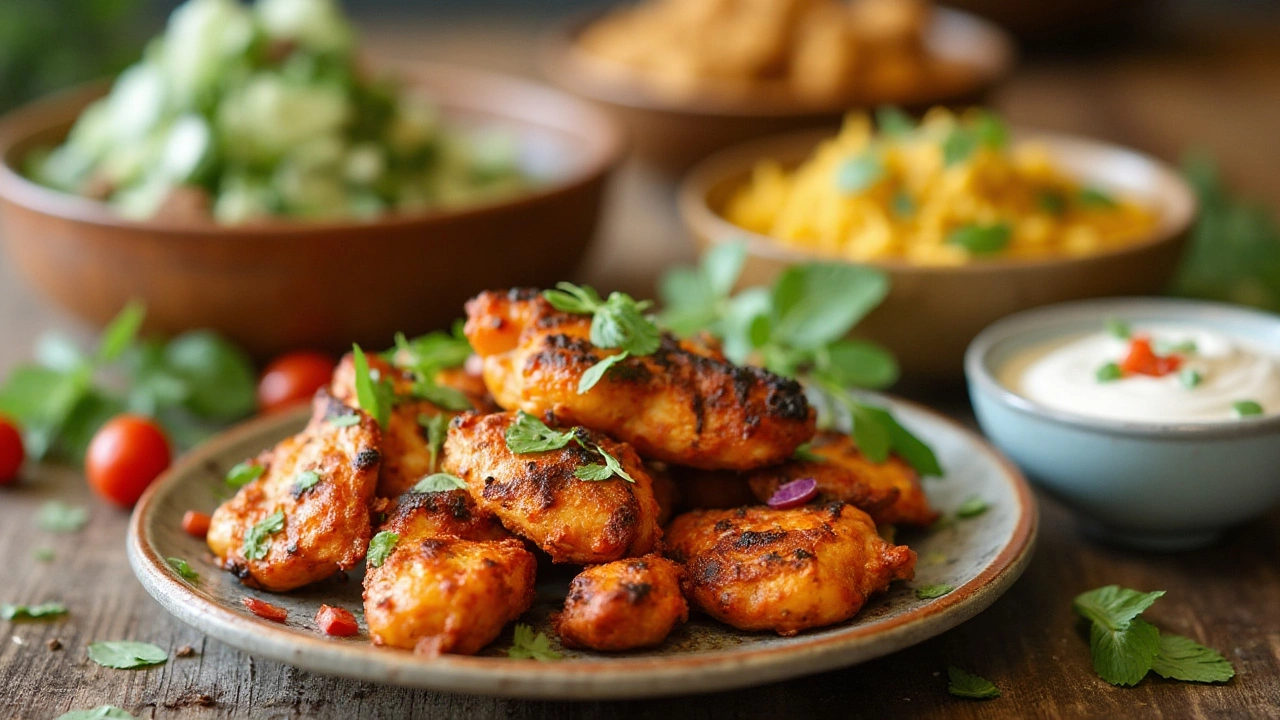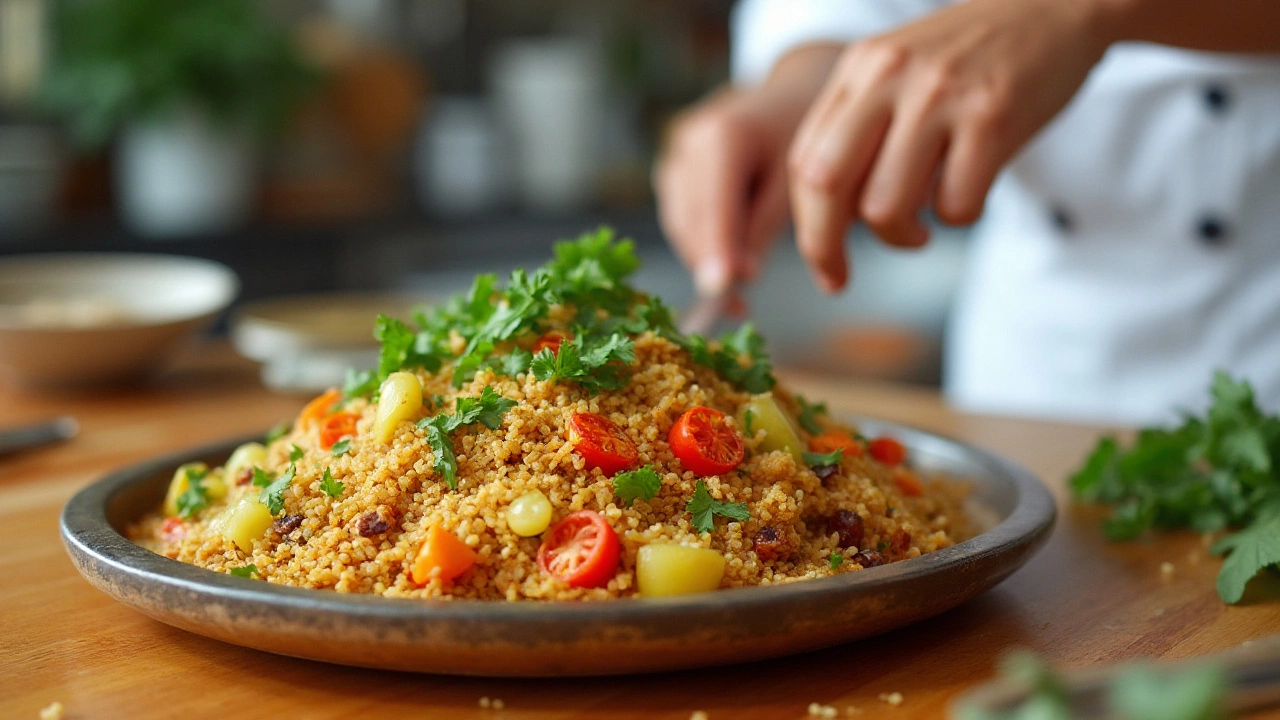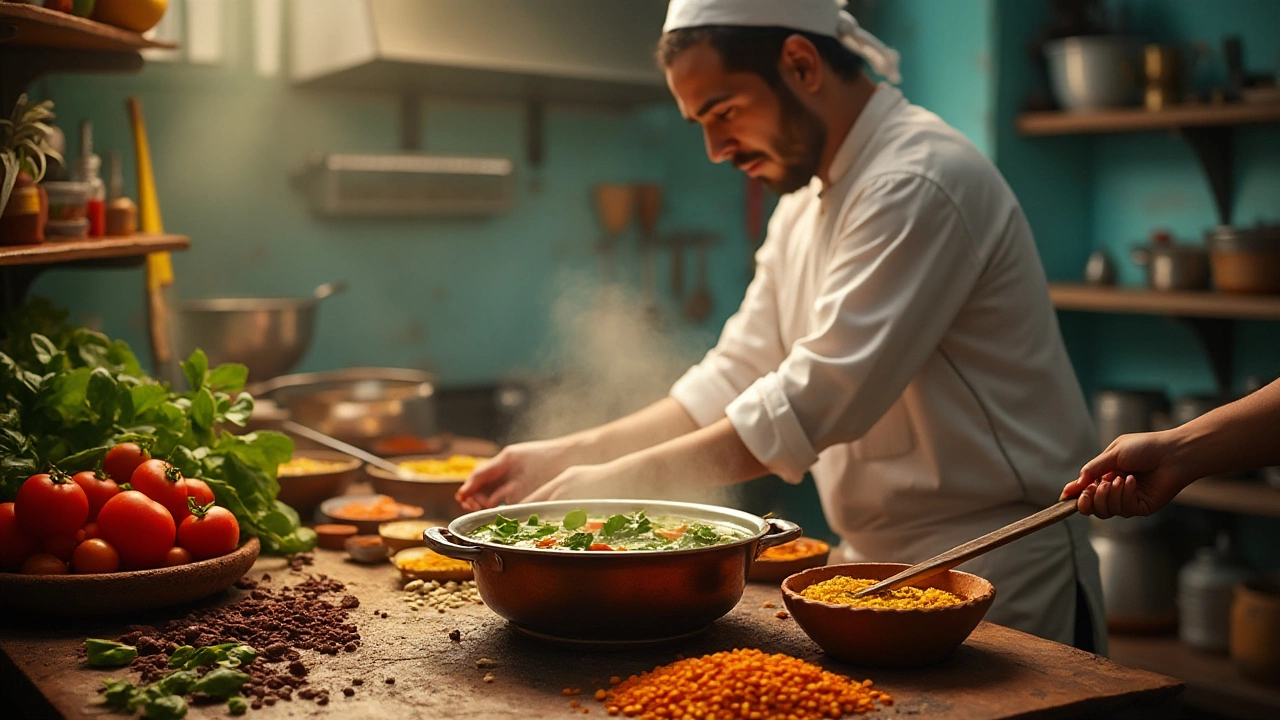24 Jan 2025
- 0 Comments
Indian cuisine is known worldwide for its vibrant flavors and rich heritage. However, it also enjoys a reputation for being hearty and indulgent. With an ever-growing focus on health, there is a rising interest in identifying which Indian dishes can be part of a healthy and balanced diet.
Understanding what makes a dish 'healthy' can be subjective, yet for many, it involves finding options that offer both nutrition and flavor without high calorie content. This quest becomes even more critical in the context of snacking, where the temptation to reach for convenient but unhealthy options is common. Thankfully, Indian culinary traditions cater to this need through a diverse range of delicacies that are healthy yet satisfying.
Let's dive into the universe of Indian snacks to find choices that not only meet the taste criteria but also the health specifications, ensuring that you can enjoy the food you love without a second thought about the scale.
- Defining Healthy and Low-Calorie Indian Dishes
- Ingredients that Make Indian Foods Nutritious
- Nutritious Alternatives to Traditional Recipes
- Cooking Techniques for Healthier Indian Dishes
- Balancing Taste and Health in Indian Snacks
- Tips for Incorporating Healthy Indian Snacks into Daily Life
Defining Healthy and Low-Calorie Indian Dishes
Indian cuisine, with its wide array of flavors and textures, offers something for everyone. Yet, when we talk about identifying healthy snacks and meals within this diverse culinary landscape, it's essential to consider both nutrition and calorie content. Traditionally, Indian dishes are crafted using whole spices, fresh vegetables, and a variety of grains, all of which can be just as keen to health as they are to taste.
One way to define healthy Indian dishes is by their ingredients. Many healthy options stem from the use of pulses and legumes like lentils, chickpeas, and beans which are rich in protein and fiber. This not only helps in keeping you full for a more extended period but is also crucial for maintaining a healthy digestive system. Incorporating such ingredients forms the backbone of dishes like dal and chana masala, which can be considered both nourishing and delicious.
Moreover, the method of cooking plays a vital role too. Techniques such as steaming, grilling, and sautéing with minimal oil lend themselves well to creating low-calorie meals. A significant advantage of preparing dishes through these methods is that they help to preserve the essential nutrients that are otherwise lost during traditional deep frying. Steamed dishes like idlis or grilled favorites like tandoori chicken can be top contenders in this category.
Spices Not Just for Flavor
Furthermore, the use of spices is not just for flavor enhancement but has health benefits. Turmeric, known for its anti-inflammatory properties, and ginger, recognized for aiding digestion, are just a couple of examples of how spices contribute to the robustness of healthful Indian dishes. They are not just calorie savers but can also help boost metabolism and promote overall well-being. In his book 'The Science of Spice', Dr. Stuart Farrimond illustrates this by saying, "Spices do more than just add flavor; they have profound nutritional benefits that can transform our bodies and minds."It might surprise some to find that low-calorie Indian dishes often include the popular and humble street foods. Options like bhel puri, composed of puffed rice, mixed with a variety of vegetables, and dahi vada, which uses yogurt—a pro-biotic rich superfood—fuse healthy components into beloved snacks. While moderation is key, these snacks cater to those craving Indian flavors without the extra calories.
Finally, it's worth noting that a balance of flavors and nutrients is imperative. Foods that satisfy the taste buds tend not to leave you yearning for more, helping to control caloric intake naturally. With modern tweaks to traditional recipes, like substituting white rice with brown rice or using multigrain flour instead of refined flour, these dishes can be made even healthier. They offer a wholesome balance that keeps in mind the essence of Indian snacks while aligning with health priorities.
Ingredients that Make Indian Foods Nutritious
When it comes to India's culinary legacy, ingredients form the foundation of its flavorful and healthy dishes. These ingredients, often sourced locally, carry distinctive characteristics that contribute to a healthier diet. They are meticulously chosen to satisfy the palate while primarily emphasizing nutrition. Turmeric, for example, is one such staple that imparts a golden hue to curries and has been recognized for its anti-inflammatory and antioxidant properties. The active compound, curcumin, has been studied for its potential to reduce the risk of chronic diseases, making it an essential addition to a diet focused on both taste and health.
Another star ingredient cherished in the Indian pantry is lentils or 'dal.' Lentils are a powerhouse of nutrition, offering a plant-based protein source rich in iron and fiber. They support heart health and provide sustained energy, making them indispensable for those seeking a steady, nutritious diet. Dal is versatile and can be prepared in numerous ways to keep meals exciting yet nutritious. According to health experts, including dal in one’s daily diet can effectively meet a significant portion of nutritional needs.
"Indian cuisine, with its varied use of legumes and spices, can be a standout option for those pursuing better nutrition," notes Dr. Meera Roshan, a nutritionist specializing in traditional diets.
The profound role of spices goes beyond flavor enhancement. Cumin seeds, often roasted and included in many spice blends, aid in digestion and boost the immune system. Similarly, fenugreek seeds have shown potential in managing blood sugar levels, making them beneficial for individuals with diabetes. Such ingredients have been carefully incorporated into recipes for centuries, underscoring the wisdom in tieing good health practices with everyday cooking.
Shifting focus to vegetables, Indian dishes often overflow with seasonal produce like spinach, cauliflower, and okra, among others, ensuring a range of vitamins and minerals. The practice of blending several vegetables into curries not just complements the spices but maximizes the nutrient intake. A traditional dish like 'saag' is rich in iron and can aid in boosting hemoglobin numbers. Asparagus beans make their way into many stir-fries, contributing not only a crunch but also vital nutrients like Vitamin C and potassium.
In addition to these, nuts and seeds such as almonds, cashews, and chia are purposefully used in moderation. They provide good fats and protein crucial for maintaining energy levels throughout the day. The elegance of incorporating such ingredients lies in understanding the balance between health and indulgence, which Indian cuisine masters so adeptly.
Consider this typical Indian scenario where nutrient-dense foods are center stage at meals. They provide a functional framework that prioritizes long-term wellness over immediate gratification. What's remarkable about these ingredients is not just their health benefits but also how they repeatedly place Indian food into the category of healthy snacks and meals. By celebrating these ingredients, one invites a wholesome and enriched lifestyle, one that Indian traditions have long advocated.

Nutritious Alternatives to Traditional Recipes
Indian cuisine, celebrated globally for its myriad flavors, often comes with a reputation of being rich and indulgent. Yet, for those on a quest for healthier options, there exist a plethora of nutritious alternatives to traditional recipes that do not compromise on taste or satisfaction. These alternatives embrace the essence of Indian cooking while offering a lighter and healthier twist, allowing you to indulge without the extra calories. One great example is the transformation of the beloved samosa. Typically fried and filled with potatoes, this snack can be quite calorie-dense. By opting to bake them, and using a filling of mixed vegetables like peas, carrots, and spinach, alongside lean proteins like chickpeas, the snack retains its appeal while packing in nutrients.
One cannot overlook the quintessential dal, which serves as a staple in Indian households. Traditionally made with ghee and sometimes tempered with creamy indulgents, a healthier approach could substitute ghee with olive oil or simply dry roast the tempering. Furthermore, adding more vegetables or using a variety of lentils can elevate the nutritional profile of this dish without altering its beloved taste. For a traditional snack turned healthy, consider the famously addictive pakoras. By switching from deep frying to baking or air frying, using chickpea flour blended with nutrient-dense greens like spinach or kale, they become a delightful treat that's kinder to your waistline.
"Traditional dishes can indeed be made healthier without losing their authenticity. It's in understanding the core ingredients and playing around with substitutions that still maintain the essence," notes renowned nutritionist Rujuta Diwekar.
The deeply satisfying paneer tikka finds healthier incarnations too. Opt for low-fat paneer and pair with a marinade rich in herbs and natural yogurt, skipping heavy creams. This ensures the dish is light but rich in proteins and taste. Lastly, let's delve into the luscious biryani. This rice dish, usually heavy with oil and rich meats, can see a transformation by using brown rice and substituting meats with more vegetables or lean proteins like tofu or chicken breast. The spices that give biryani its signature taste remain, ensuring that the experience is as delightful as the original. To aid you in exploring these swaps, a table of common substitutions that help lighten your cooking:
| Traditional Ingredient | Healthier Alternative |
|---|---|
| White Rice | Brown Rice |
| Ghee | Olive Oil |
| Heavy Cream | Low-Fat Yogurt |
| Pork/Lamb | Chicken Breast/Tofu |
These low-calorie Indian foods demonstrate that with a bit of creativity, you can still enjoy the vibrant flavors of India's rich culinary heritage without sacrificing your health goals. As you embark on incorporating these healthier adjustments, ensure to stay authentic to your tastes and preferences, as true enjoyment in food comes equally from its flavor as its benefits.
Cooking Techniques for Healthier Indian Dishes
Incorporating healthy cooking techniques without sacrificing the bold flavors that characterize Indian snacks is a balance sought by health enthusiasts. Traditional Indian cooking often relies on lavish use of oils and fats, but there are modern methods that preserve taste while promoting health. Embracing these techniques can significantly cut down the calorie content in your favorite Indian dishes.
One method gaining popularity is steaming. Steaming retains nutrients and flavor while avoiding added fats. For instance, popular snacks like idlis are a staple in southern India, traditionally steamed, making them naturally low-calorie and healthy. Another approach is grilling or baking instead of frying. This technique allows the use of minimal oil, thus cutting down on unnecessary calories while maintaining a delightful crunch—a key attribute of snacks like samosas or pakoras.
"Healthy cooking is not necessarily about cutting down on flavors; it's about enhancing them without the extra calories," says renowned chef Manjit Singh Gill.
Just by slightly tweaking your regular recipes, you can cherish every bite with the same affection.For example, tempering spices in minimal oil can extract flavors effectively. This reduction in oil not only lowers calorie content but also highlights the natural essence of spices, enriching the culinary experience.
Beyond methods, incorporating specific utensils can also make a difference. Non-stick pans, for instance, permit cooking with little to no oil. The impact of this on high-calorie dishes is substantial. The versatility of a non-stick pan allows you to still create the crispy texture of a dish without deep frying. Pressure cookers, too, minimize the need for excessive fats, making them ideal for cooking dishes like dal or kichdi that are both nutritious and comforting.
For a nuanced understanding of how these methods translate into healthier meals, consider the following sample nutrition comparison:
| Cooking Method | Calories per Serving | Oil Used (ml) |
|---|---|---|
| Deep Fried | 250 | 20 |
| Baked | 180 | 5 |
| Steamed | 120 | 0 |
Exploring these options can not only foster a healthier lifestyle but also inspire creativity in the kitchen. Adjusting cooking techniques allows you to enjoy the low-calorie Indian food you love, making them perfect choices for every health-conscious individual. With the right approach, traditional Indian snacks can become regular features in any diet plan.

Balancing Taste and Health in Indian Snacks
Creating a balance between taste and health may often seem like a daunting task, especially when it comes to Indian snacks which are typically laden with rich flavors and spices. The secret lies in understanding the core ingredients that contribute significantly to enhancing taste while also maintaining a healthy profile. An excellent example of this is the use of spices such as turmeric, cumin, and coriander. These are not only staple elements for flavor but also packed with significant health benefits, from anti-inflammatory properties to aiding digestion effectively.
One might argue that traditional fried snacks are simply without compare. However, with a bit of creativity and mindful cooking, healthier alternatives can be crafted without compromising on the essence of flavor. For instance, traditional samosas can be reinvented using whole wheat pastry sheets and baking instead of deep-frying. This method reduces the calorie intake notably while still allowing the enjoyment of a well-loved snack. The filling can incorporate a mix of seasonal vegetables, which boosts both the taste and nutritional value.
"When you choose snacks that nourish both your body and soul, you are practicing a form of self-love no different from any deliberate act of self-care," notes renowned nutritionist Rujuta Diwekar.Customizing recipes can also mean introducing less familiar ingredients like millet or quinoa, which are lesser-known but excellent grain options packed with nutrients and make a fulfilling base for various dishes. By simply switching refined flour to multigrain, dishes like dosas or parathas can become significantly healthier, being both light and satisfying to the palate.
The cooking methods employed also play a crucial role in this balancing act. While traditional recipes may call for frying, modern adaptations emphasize the use of steaming, roasting, or grilling, thereby reducing unhealthy fats. Air frying has emerged as a popular method, offering a crispy texture that can rival the deep-fried version. These cooking techniques preserve the essence of traditional flavors while catering to a health-conscious crowd. Healthy snacks also offer a platform for creative experimentation. Experimenting with dips and accompaniments, such as using yogurt-based chutneys or hummus, adds a dash of health while elevating taste profiles. And it’s these accompaniments, rich in probiotics or fiber, that can enrich the health quotient of Indian dishes. Consider presenting snacks with a side of carrot or beetroot salad to rejuvenate the presentation and taste.
The concept of mindful eating involves understanding both the nutrient content and the portion sizes served. It's about savoring each bite slowly and appreciating the combined taste and texture, rather than rushing through a meal. This mindful approach can significantly reduce overeating, encouraging a healthier, more balanced diet when combined with smart choices. So, in this quest for a balance between taste and health, embrace the rich diversity of Indian snacks and remain open to modifying traditional recipes. With little effort, you can enjoy the best flavors while nurturing the body through wise culinary decisions.
Tips for Incorporating Healthy Indian Snacks into Daily Life
Adopting a healthier lifestyle doesn't mean you have to give up on flavorful foods, particularly when it comes to Indian snacks. The key is finding ways to integrate these delicious bites into your routine without undermining your health goals. One practical tip is to start by prepping your snacks in advance. Sunday afternoons can be your dedicated time to prepare an array of options like roasted chickpeas or masala oats that are rich in fiber and protein. These can be stored easily and act as a quick go-to during your hectic workdays. By having these snacks ready, you reduce the temptation to reach for something less nutritious when hunger strikes.
Another approach is to make smarter choices when dining out or ordering Indian food. Look for restaurants that offer low-calorie Indian food options, such as salads with lemon-turmeric dressing or grilled paneer skewers. Asking the chef to customize your meal by reducing the oil or butter used can also make a difference. You might find that such places offer a separate healthy menu, making it easier to maintain your diet even when enjoying a meal out. Keep in mind that portions often matter more than we realize; sharing dishes means you can try different items without overindulging.
"Cooking with heart can transform your lifestyle—Indian cuisine, when done with care, complements a healthy living," says culinary expert Sanjeev Kapoor.Exploring cooking classes focused on healthy Indian dishes can also boost your journey. Learning from professionals provides insights into ingredient swaps, like replacing refined flour with whole-grain alternatives or using air-fryers rather than deep-frying your snacks. Incorporating more seasonal vegetables and fresh herbs such as coriander or mint doesn't just add flavor but amplifies the nutritional value of your meals.
For others who thrive on community interactions, joining a local cooking club or online group focused on healthy Indian snacks can be an invaluable resource. Exchanging recipes, participating in food challenges, and receiving feedback can motivate and inspire you to try new things. These communities often host cooking workshops or potlucks, obliterating the myth that healthy eating is isolating or boring. Plus, these social experiences can lead to lifelong friendships and support systems that enrich your life well beyond the culinary realm.
Let’s not forget about the power of technological tools in your kitchen. Engaging with apps that offer diet tracking and provide nutritional information can aid in staying accountable. With these, you can plan meals more effectively, ensuring your pantry is stocked with the right ingredients to make your low-calorie Indian food a breeze to prepare. There are also specialized apps for Indian cooking that offer healthier tweaks to traditional recipes, so you never run out of ideas to satisfy your cravings healthily. By blending technology with tradition, you're setting a sustainable groundwork for lifelong dietary habits.
